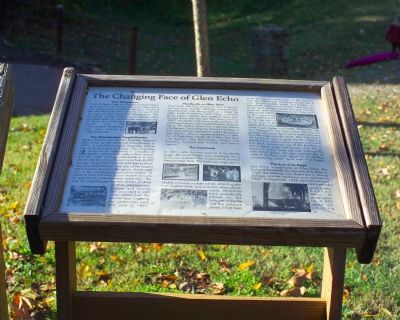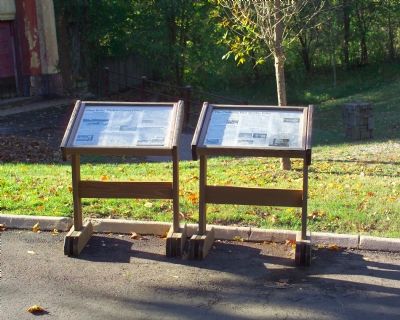Glen Echo in Montgomery County, Maryland — The American Northeast (Mid-Atlantic)
The Changing Face of Glen Echo
The Chautauqua Amphitheater. When Edward and Edwin Baltzley opened Glen Echo as the National Chautauqua in 1891, it included a public assembly hall as one of its principal buildings. The amphitheater, designed by Theophilus P. Chandler of Philadelphia, spanned the valley in front of you, with the creek running underneath it. It was electrically lit and could seat more than 8,000 people. Topped with a dome 250 feet in diameter, the Amphitheater was one of the largest performance spaces in the nation. It was used for, as the Chautauqua curriculum stated, “A series of three first-class lyceum lecture concerts of spectacular entertainments each day.” Below the amphitheater lay two stories of stone grottoes, passageways, bridges and alcoves that provided a welcome retreat from the summer heat. Opening day ceremonies were held June 16, 1891.
Vaudeville at Glen Echo. Regretfully, the Chautauqua at Glen Echo did not last long, and by 1892 the extraordinary amphitheater was being used as a stage for other kinds of entertainment. Plays, concerts, prize fights, operas and contests were performed there over the next few years, and by 1897 Vaudeville had become the primary entertainment shown at the amphitheater. According to The Washington Post, it played host to entertainers “including the famous Fadettes, a lady orchestra of twenty-five skilled musicians from Boston...This is supplemented by a number of high-class vaudeville artists ... Van Leer and Barton, ... the Brownings, ... Baker and Randall, ... Caswell and Arnold ... and Emma Francis.
The Funhouse. In 1911, after its short time as a Vaudeville stage, the amphitheater was converted into a funhouse, modeled after Coney Island’s famous Steeplechase Park. The funhouse originally included a human roulette wheel, distorting mirrors, a giant slide, and a dozen other amusements. Attractions were periodically added to the funhouse, so that by the time the funhouse closed, it had been home to such entertainments as the Rocking Pigs, the Whirl-i-gig, Crossing The Ice and a new human roulette wheel. The human roulette wheel, later turned into The Tubs, was one of the more popular attractions and was featured in most advertisements for Glen Echo Park. It
was a floor level spinning disc, and the point of the ride was to stay in the center of the wheel while it spun faster and faster. When the ride was changed to The Tubs it was sunk into the ground and guests tried to make their way from the edge to the center. Also included in the funhouse were a giant barrel, called the Barrel of Fun, which rolled in place, and a 600 foot track around the top of the building on which guests could ride scooter cars. An operator up in the tower ran and watched the rides down below. He also operated the air vents in the floor, with which he would blow unsuspecting ladies’ skirts over their heads.
The End of its Days. Like many amusements at Glen Echo, the funhouse eventually saw the end of its days. In 1948 the midway was closed due to termite damage, and the attractions were removed in 1949. In September 1956, the funhouse was destroyed for good. It was burned down to make room for a 300 space parking lot.
Topics. This historical marker is listed in these topic lists: Arts, Letters, Music • Education • Entertainment • Parks & Recreational Areas. A significant historical date for this entry is June 16, 1891.
Location. 38° 57.983′ N, 77° 8.359′ W. Marker is in Glen Echo, Maryland, in Montgomery County. Marker is on Macarthur Boulevard, ¼ mile Goldsboro Road. Touch for map. Marker is in this post office area: Glen Echo MD 20812, United States of America. Touch for directions.
Other nearby markers. At least 11 other markers are within walking distance of this marker. Glen Echo Park’s Crystal Pool (here, next to this marker); The Roller Coasters of Glen Echo Amusement Park (a few steps from this marker); 1921 (a few steps from this marker); The Glen Echo Park Yurts (within shouting distance of this marker); Glen Echo Park (within shouting distance of this marker); Glen Echo From Past to Present (within shouting distance of this marker); c. 1931 (within shouting distance of this marker); a different marker also named 1921 (within shouting distance of this marker); Glen Echo Civil Rights Protest (within shouting distance of this marker); a different marker also named Glen Echo Park (within shouting distance of this marker); Minnehaha Creek (within shouting distance of this marker). Touch for a list and map of all markers in Glen Echo.
Related markers. Click here for a list of markers that are related to this marker. To better understand the relationship, study each marker in the order shown.
Also see . . . Real Photo Postcards. Almost from the first, Glen Echo used postcards to promote the park. (Submitted on June 2, 2010, by Mike Stroud of Bluffton, South Carolina.)
Credits. This page was last revised on January 12, 2020. It was originally submitted on October 30, 2007, by Tom Fuchs of Greenbelt, Maryland. This page has been viewed 2,878 times since then and 18 times this year. Photos: 1, 2. submitted on October 30, 2007, by Tom Fuchs of Greenbelt, Maryland. • J. J. Prats was the editor who published this page.

